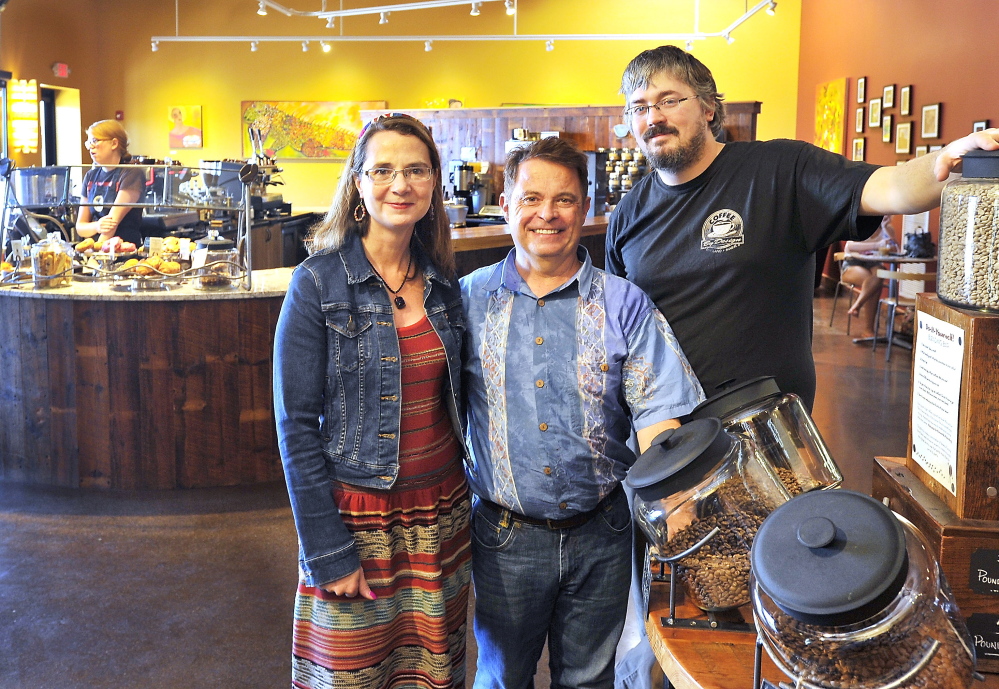In theory, moving into a 45,000-square-foot space was a dream come true for Coffee By Design owners Mary Allen Lindemann and Alan Spear.
The space would be enough to accommodate production, a warehouse, corporate offices and a coffee bar under one roof. Their $7 million company is an artisan micro-roastery, which custom-roasts and blends coffee to order for its five cafes in Maine and 400 wholesale customers throughout the United States.
But for the past nine years, they’d been operating out of a 3,000-square-foot production space on Washington Avenue and stashing supplies in a 10,000-square-foot facility behind it. They were constantly tweaking the production line to create more efficient systems.
“The system worked as it was, but we realized that if we had 20 percent more production it wasn’t going to,” Spear said. “We wanted to be as fluid as possible so that we can look not only from today but how we’re going to be five or 10 years from now.”
When they started to look for bigger space, they realized it was an opportunity to design production to accommodate future growth. But they quickly realized that their design expertise did not necessarily extend beyond coffee.
“We realized that we know how to do great coffee, and we know the industry. But we know very little about designing a manufacturing plant,” said Dylan Hardman, CBD’s head roaster.
The company contacted the Maine Manufacturing Extension Partnership, or MaineMEP, which provides business and technical assistance to small manufacturers. With MaineMEP’s Bill Whittier, they worked through a process for configuring space called Systemic Layout Planning used in factories, warehouses, labs, offices and hospitals to make operations more efficient. The goal is to reduce the amount of time, energy and movement that’s wasted every day.
Through a series of half-day meetings between January and March, Whittier met with Spear, Hardman and the 10-member roastery staff to determine what kinds of equipment, supplies and employees needed to be close together to make the production line more efficient.
A key question was where to place the centerpiece of their production line – two Loring Kestrel roasters, which weigh 75 and 150 pounds. The roasters are difficult and expensive to move, because they each require connections to data, electricity, natural gas, water and compressed air.
“If we put them in the wrong place, that would have thrown everything off,” Spear said.
The process started with evaluating – at a microscopic level – the way they were currently working. Each employee was given a log and for two weeks was asked to record examples of waste they observed. When they regrouped to share findings, they had amassed 95 examples of waste, ranging from the time they spent packaging coffee orders to how many times a product crossed the same production space.
“It was mind-boggling,” Hardman said.
The analysis also gave Spear and Hardman the chance to hear how the workers saw their individual duties.
“It encouraged everybody to think critically about what they do,” Spear said. “And it was interesting to see what was important to them, and to be able to incorporate their feedback in the process.”
For instance, they originally planned to have all products and supplies, like the green coffee beans, come into the facility through one loading dock in the front of the building, and exit through the back. But that would have required building expensive new loading docks. Instead, they reconfigured the production line into a U-shape, so they could use the existing set of loading docks to bring raw ingredients in, and send finished products out.
By bringing the packaging materials closer to the roasters, they were able to cut the time from roasting to packaging from two hours to less than 15 minutes. After the beans are roasted, they go directly into bags, where they are labeled and put on steel rolling racks. The racks roll the beans into vans for store deliveries.
“It’s so much simpler,” Spear said. “And it’s easier to see that orders are correct and complete.”
In the nine months since moving to Diamond Street, the roastery is functioning more efficiently and has increased production by 20 percent, Spear said. Shipping is more systematic and inventory control is much easier, minimizing shortages. As a result, production has increased but the team’s workday has not. Revenues and profitability are up, and that has resulted in a 10 percent to 15 percent wage increase for staff.
Now that all the production workers can see one another most of the time, there’s more camaraderie and opportunity to cross-train. That means workers can be more versatile, grow professionally and there’s less stress when someone is out on vacation or sick.
“It’s definitely a less chaotic environment,” Hardman said. “Now I go home feeling accomplished, but not so worn out.”
Jennifer Van Allen can be contacted at 791-6316 or at:
jvanallen@pressherald.com
Send questions/comments to the editors.



Comments are no longer available on this story